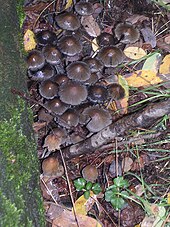Common mica ink
| Common mica ink | ||||||||||||
|---|---|---|---|---|---|---|---|---|---|---|---|---|

Common mica ink ( Coprinellus micaceus ) |
||||||||||||
| Systematics | ||||||||||||
|
||||||||||||
| Scientific name | ||||||||||||
| Coprinellus micaceus | ||||||||||||
| ( Bull .: Fr. ) Fr. |
The common mica ink ( Coprinellus micaceus , Syn .: Coprinus micaceus ) is a type of mushroom from the family of the mollusc relatives (Psathyrellaceae).
features
Macroscopic features
The hat of the mica tint is up to 3 cm wide and 2.5 cm thick. The hat shape is egg-shaped at the beginning and gradually bulges outwards in a bell shape, with its diameter increasing to 5 centimeters. It has a cream-colored to ocher-brown or fuchsia coloration that darkens towards the middle of the hat. The hat skin is initially grooved almost to the top, but with increasing age it becomes wrinkled. Young mushrooms are covered with small glimmering, glittering scales ( remains of velum ), which are initially dense and flat, then tear open in a crumbly, lumpy manner. They disappear quickly when it rains. The lamellae are initially whitish to yellowish white, then gray-brown to gray-purple and black with age. However, they do not dissolve properly. The mica ink has white flesh. Its smell and taste are inconspicuous. The stem becomes 3–8 (-10) cm long and 3–5 mm thick. It is white and shiny, hollow and not very stable. The base is slightly to clearly thickened and slightly ocher in color. In young mushrooms, the stem is covered with fine flakes; older ones often appear smooth.
Microscopic features
The spores are colored brown. They are 6.5–9.5 × 4.5–6.5 × 4–5 micrometers in size and appear pear-shaped to rhombic when viewed from the front and elliptical to slightly almond -shaped when viewed from the side. In addition, they are characterized by a strongly advanced germ pore. The cheilo and pleuro cystids are vesicular . There are bottle-shaped caulocystids on the stem. With their long neck, they have a length of up to 100 µm.
Species delimitation
The mica ink has a number of similar types, which can usually only be distinguished with a little experience; but sometimes even then not with certainty or only microscopically. The closer relationship of the mica tintling (Sekt. Micacei s. Str.) Can be limited by the comparatively strong tones of the hat and the glimmering, shimmering remains of the velum. Microscopically, the latter only consist of rounded cells. The mica ink is well identified among the closest relatives by the Kaulocystiden , which can already be seen with a magnifying glass or sometimes even with the naked eye. These properties are lacking in the outwardly very similar sugary tintling ( Coprinellus saccharinus ) and the willow tintling ( Coprinellus truncorum ). The spores of the latter also have no protruding germ pore and therefore appear elliptical . In the case of sugar-coated ink, the spherical elements of the velum measure up to 40 µm, whereas in the case of mica ink, up to 70 µm.
When the velum remains have been washed off the hat, there is a resemblance to the small Rauspor-Tintling ( Coprinellus silvaticus ). This is rarer and has warty spores. Cystidia can be seen on the hat with a magnifying glass. Other similar types of tintlings (Sekt. Domestici s. Str.) Can be separated by flat-skin-like remains of velum and paler hat colors.
Ecology and phenology
The mica tintling can be found in deciduous and mixed forests of all kinds, but rarely in coniferous forests. It often grows in gardens, parks and similar biotopes such as roadsides and bushes. The fungus lives as a saprobiont on rotten wood. It is also found on buried wood and at the base of living trees. The latter occurrence may indicate a parasitism of the fungus at the root. Nutrient-rich substrates are preferred, but this tint is not picky about the pH value of the soil ( soil-vague ).
The fruiting bodies can appear all year round, but they appear much more frequently in the mild months from April to November. They grow in clumps or grass on hardwood.
distribution
The mica tintling is a cosmopolitan that - apart from Antarctica - occurs on all continents. The mushroom can be found almost everywhere in Europe, including Great Britain, France, Sweden, Russia and Turkey. The species is common everywhere in Germany.
meaning
The mica tintling is edible and, when young, is a tasty soup mushroom. However, the mushroom is said to contain the fungal toxin coprin , which has already been detected in the closely related wrinkle ink and can lead to symptoms of poisoning in connection with alcohol consumption up to about four days after consumption of the mushroom. Coprin blocks the enzyme acetaldehyde dehydrogenase , which breaks down acetaldehyde , which is primarily produced in the body when ethanol (alcohol) is broken down. However, the presence of this poison is questioned.
swell
literature
- German Josef Krieglsteiner , Andreas Gminder (Hrsg.): Die Großpilze Baden-Württemberg . Volume 5: Mushrooms. Agarics III. Ulmer, Stuttgart 2010, ISBN 978-3-8001-3572-1 .
Individual evidence
- ↑ fungal Compendium. Volume 2: Descriptions. The larger genera of the Agaricales with colored spore powder (except Cortinariaceae) . Fungicon Verlag, Berlin 2007, ISBN 978-3-940316-01-1 . P. 232 f.
- ↑ a b Glistening Inkcap at giftpflanzen.com
Web links
- Coprinus micaceus - mica ink
- The mica tintling at www.natur-in-nrw.de
- Glistening Inkcap at natur-lexikon.com


